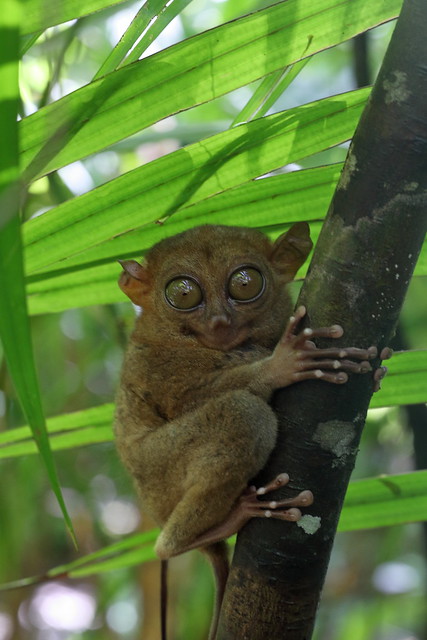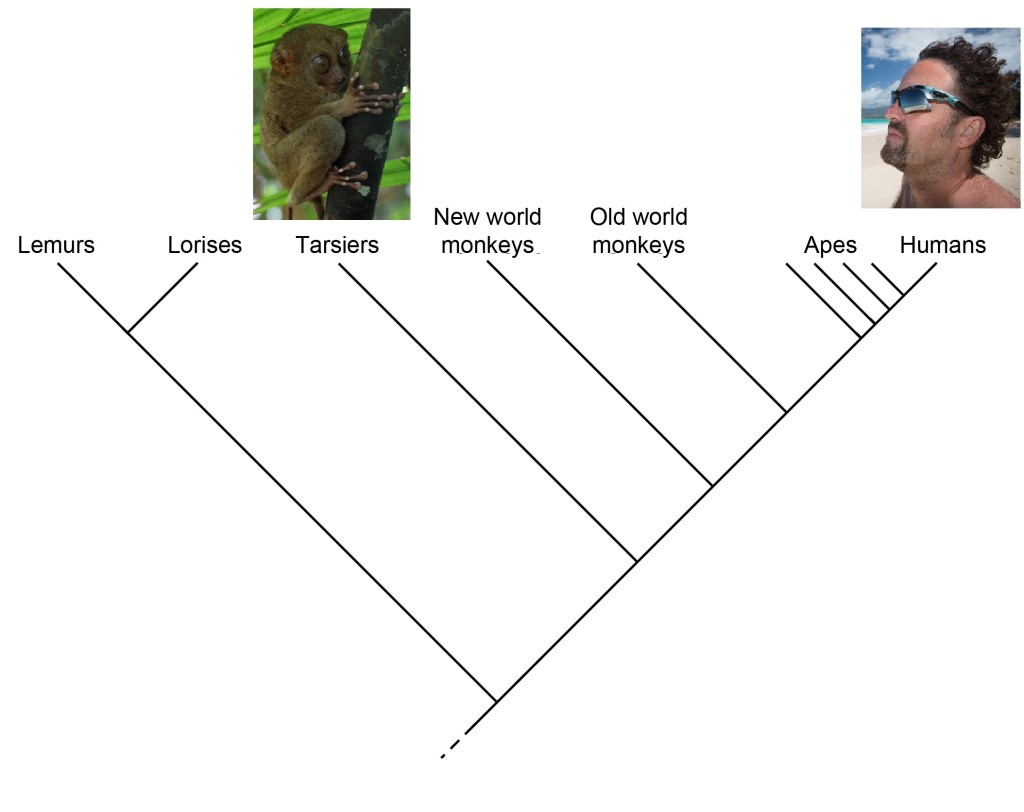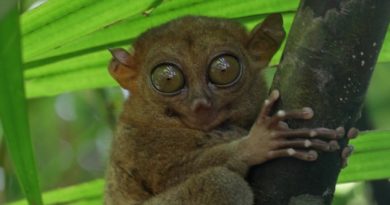Primate Evolution, Free Will and Islands
I recently had the chance to observe and photograph the Philippine tarsier (Carlito syricha), a small monkey living in the inland forests of Bohol in the Philippines. It’s a curious animal: about the size of a small rabbit, but with long legs and arms, skinny fingers and large hypnotic eyes. There is no doubt that it had served as the inspiration for Star Wars’ Yoda, who looks like a severely aged, bald tarsier. This is the real version, which can’t wield a light-saber or speak English, not even with messed-up grammar:

I saw the tarsier in the Bohol Tarsier Sanctuary, which is a great organization truly dedicated to the conservation of this unusual species. There, an area maybe a hundred meters long and wide is fenced-in, for the protection of the tarsiers. Feral cats and dogs are a major threat to these animals. The tarsiers are nocturnal, and hunt mainly insects during the night. The very large eyes give them an excellent night-vision capability. During the day, they just rest on bamboo or on trees. Sometimes they turn their heads a bit, or wiggle their ears.
In the Tarsier Sanctuary, a few paths lead through pretty dense tropical vegetation, how it would grow all over inland Bohol without humans. Every couple of meters sits a tarsier, conveniently usually at about human eye-level. Still, they are not easy to find, as they are small and their brown fur blends right in with the trees. Every couple of meters on the foot paths walks a group of tourists, mostly Koreans. The Filipino tarser guards make sure the tourists 1. actually see the tarsiers 2. shut up, since the small monkeys are very noise sensitive 3. don’t stick their smart phones too close into the faces of the tarsiers. In-between the tourists walked, last Saturday, The Pacificklaus, with a sweaty t-shirt courtesy of the tropical heat, and a
connected to a
instead of a smart phone. Now, smart phone cameras have of course made great strides, but their lenses and light-sensors are still much smaller than those of digital SLRs. Simply by the laws of camera physics (explained here) this means that images under low-light conditions (like in a dense forest), without the use of a strobe (not allowed when photographing light-sensitive tarsiers, you will need to use a high ISO value) SLR pictures will come out significantly less grainy. This is one of the photographic situations where a big camera actually makes a positive difference. Ha!
A big camera also makes a difference in the authority you exert as a photographer. When changing lenses away from any tarsier-ladden trees, I took a while to just scan the shrubbery for butterflies, lizards or just plain nice tropical vegetation. Holding this forearm-sized lens in my hand (I tried to use the 300mm f4 for a while, but there was just not enough light for it) I must have looked like a man who knows what he is looking at. A group of 5 or 6 tourists stopped behind me and looked in the same direction, and looked, and looked … I finally had to tell them that there was no tarsier in sight.
After this quick excursion into the physics and sociology of photography back to the tarsier: It sits at an interesting position in the primate family tree. It branched off after the Madagascan lemurs, but before the last common ancestor of all other monkeys, apes and humans:
This can be seen very clearly when comparing the skeleton of a modern tarsier, on top (seen in the Tarsier Sanctuary) with the fossilized bones of one of the oldest known monkeys, Archicebus achilles, dating back 55 million years (top image of a recently deceased tarsier by myself, taken in the Tarsier Sanctuary, bottom picture of a 55 million-year-dead Archicebus achilles by Xijun Ni via Wikipedia):
These first monkeys were quite similar to modern day tarsiers: The tail, pelvis and limbs were very similar, and so was the head. The teeth of Archicebus were pointy, pointing to an insect diet like the one the modern-day tarsiers are eating. Just the eyes were smaller in the 55 million year old monkeys, which leads us to the conclusion that they were active during the day, unlike the nocturnal modern tarsiers. So, when looking at a tarsier in the forest in Bohol we see an animal which is quite close to our own ancestor, and the last common ancestor of all living monkeys, from the Eocene period. Amazing. I’m not sure if many of the people who visit the tarsiers in Bohol as a part of an island tour (chocolate hills, old church, river cruise …) realize what kind of important animal they are looking at! The Tarsier Sanctuary actually has some really good information in the entrance area, but a lot of people just rush through to see the cute monkeys.
This still leaves us with the question why there are such tarsiers in Bohol in The Philippines, and in not that many other places in the world (Sulawesi and a few other islands in Indonesia have related tarsier species). And it makes me wonder how animals can develop in such different directions: At one point, a group a proto-tarsiers split into two, and the ancestors of group one still climb around on trees and chew grasshoppers, while the other group’s descendants grew 1000 times in size and now manufacture devices with sophisticated optics and semiconductor chips to record images of the few remaining representatives of group one. Besides the question who made the happier choice (I have not tried the naked tree-dwelling, insect-chewing lifestyle, so I can’t judge), the difference is astonishing. How did it come about?
The evolution of primates, which first appeared in the Eocene (55 million years ago), possibly first in Asia, was massively shaped by the changing configuration of continents and the resulting climate changes. Primates don’t do very well in cold climate, and hence the changing global temperatures, and the changing extend of tropical climate zones on our planet made their distributions change significantly during the last 55 million years. Currently, Australia, Europe and Antarctica are primate less (when counting humans only as an invasive species). In the warmer past, Europe was home to a flourishing primate fauna. The new world monkeys possibly reached South America via only a few floats drifting across the (then narrower) south Atlantic ocean.
So chance played a big part in primate evolution: ending up on the wrong side of a land bridge could drive your lineage into one particular line of evolutionary development, or even extinction.
I do want to speculate here that in such big-brained creatures like primates, with such complex behavior, behavior played an especially prominent role in shaping the course of evolution. Complex animals like primates can alter their behavior much more than some lowly slug or worm! A decision of one primate group to move to a new habitat could expose them to a whole new set of adaptive pressures: New food sources, predators and parasites would affect the evolution of that primate group after the decision to move. Curiosity, risk-taking and novelty-seeking of the individual will all potentially influence the course of the evolution of the species. The importance of behavior for evolution has long been recognized. I believe that it could have been especially important in the behaviorally complex primates, with their wildly changing distributions over the last 55 million years.
Lastly, why are the tarsiers found only on the islands of Southeast Asia today? Archicebus was dug up in China, on continental Asia, modern tarsiers don’t live there anymore. Frequently relict populations of previously more widespread animals occur on islands, such as a fishing cat not found anywhere else in Asia but on Iriomote island/Okinawa in the Ryukyu islands, or the many lemur species on Madagascar. Most of the Philippines are oceanic volcanic islands and were never connected to any continents (Sunda-plate Palawan is an exception), while Sulawesi is a continental island. Both are isolated from mainland Asia and its fauna with its dangerous predators such as big cats. The adaptive pressures seem to be less on smaller, more isolated islands. Islands are refuges from the harsher biological realities of large continents. In evolutionarily recent times, these realities also included humans, which settled the Philippines only a few 10000 years ago. The late arrival of humans, who were mostly already agriculturalists at that time, might have played a part in saving a species which would otherwise be a tasty piece of meat passively siting on a tree during the day. Such a piece of comfort food would be irresistible for a hunter-gatherer with time to browse the shrubbery all day. The relatively late arrival of humans in the Philippines might have helped the tarsiers.
Worth reading, with fewer pictures of cute furry monkeys than in my blog post, but academically very solid and concerned with the same issues:
The Biogeography of Primate Evolution: The Role of Plate Tectonics, Climate and Chance. John G. Fleagle and Christopher C. Gilbert. Primate Biogeography, edited by Shawn M. Lehman and John G. Fleagle. Springer, New York, 2006.
Lastly, I also made a short video about the tarsiers of Bohol:





